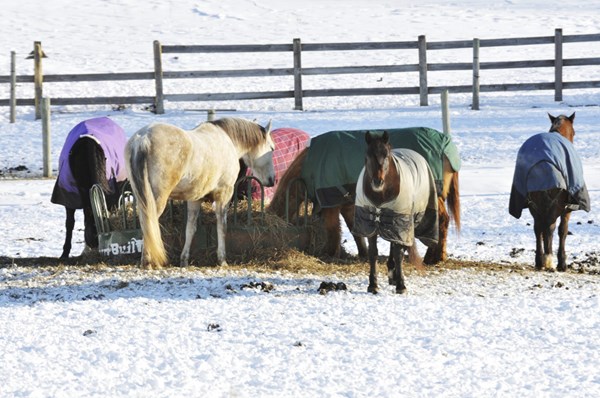 Credit: Thinkstock
Credit: ThinkstockBelow freezing temperatures can make hibernation look tempting, but inactivity in horses can lead to many issues, including lameness. Even though the weather outside may be frightful, your horse’s need for mobility has not changed. As a grazing animal, horses naturally move and eat for the better part of a day, but this can prove challenging when a winter storm hits.
Many horses will stay put by the hay feeder and you will see no evidence of tracks elsewhere in your snowy fields. Feeding hay in several different locations throughout the paddock can encourage travel, which not only encourages healthy limbs, but also aids in digestion. Be sure the paddock is free of dangerous footing and clean up any decaying forage before spring.
What is your winter plan? When the paddock freezes, your horse might not be able to go outside if the risk of slipping makes conditions dangerous. Those with indoor riding rings have an area to help maintain movement. If you do not have this luxury, hand walking horses where it is safe may be one of your limited options.
Winter presents more problems than just storms. Hard ground in the winter can be the perfect storm for bruised feet. It is good practice to keep your horse on a regular schedule with the farrier. If bruising is a recurring problem, seek their advice on options for your horse’s feet. Bruising leading to abscess formation is another common winter foe.
Immobility can have negative effects including joint stiffness and losing range of motion in horses suffering from arthritis. To learn more about lameness detection, check out Equine Guelph’s online healthcare tool ‘Lameness Lab’ sponsored by Zoetis.
The Lameness Lab will allow horse owners to discover the causes and factors contributing to increased risk. You will learn about the body tissues involved and how to tell if your horse is lame. Plus, see videos of lame horses; test your knowledge and find out how a veterinarian detects lameness.
Manager of Equine Veterinary Services at Zoetis, Cathy Rae said, “We hope that by visiting the Lameness Lab, horse owners can develop or sharpen their skills in early lameness detection, and work with their veterinarians to ensure that their horses are ‘road ready’ when winter is FINALLY over.”
Learn something new about lameness. Go to Equine Guelph’s Lameness Lab. Zoetis also sponsors ‘Journey through the Joints’, another tool to help horse owners understand inflammation and how it affects the health of their horses joints.
Please note: This information provides guidelines only and should never replace information from your veterinarian.
This article was written by Jackie Bellamy-Zions.


